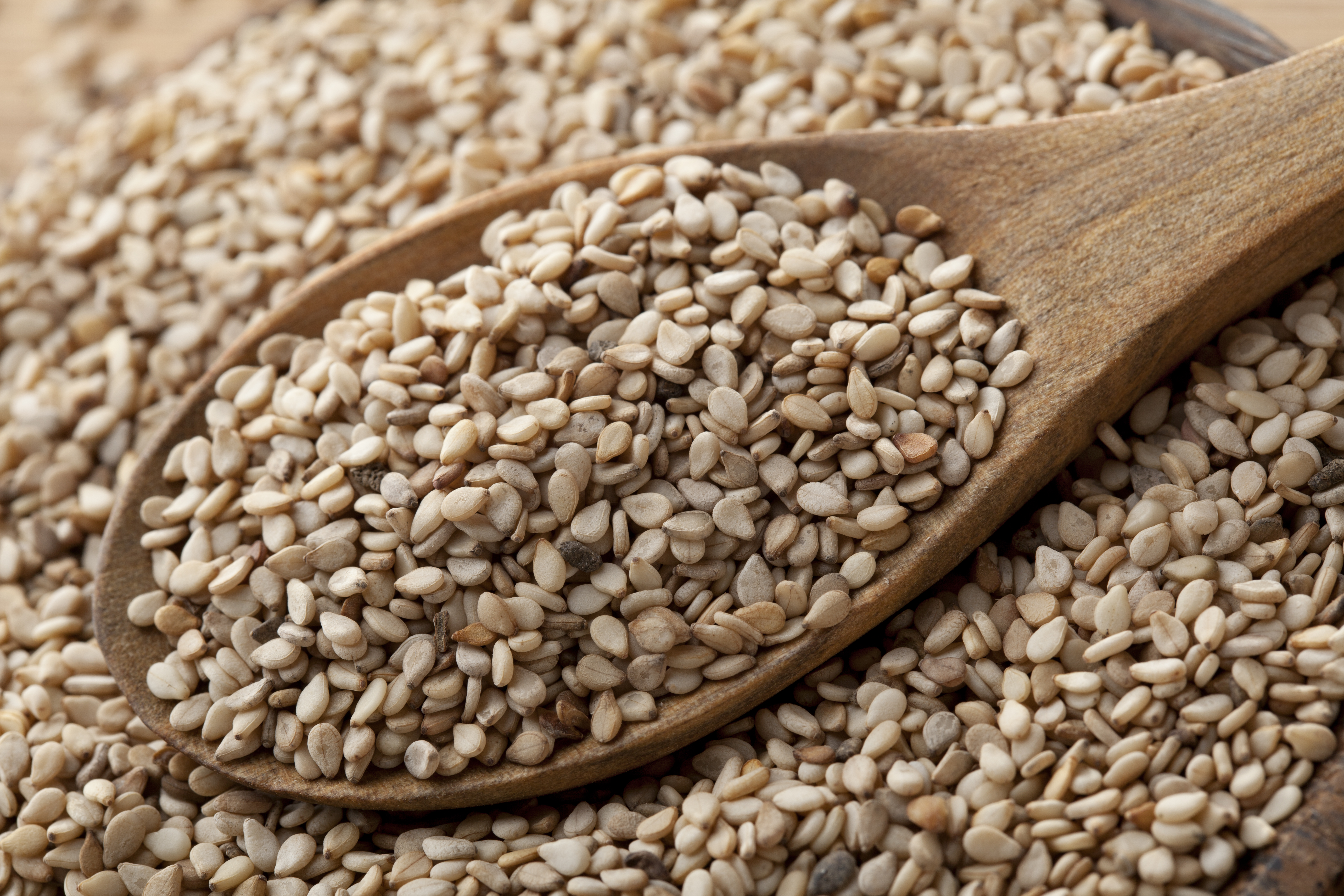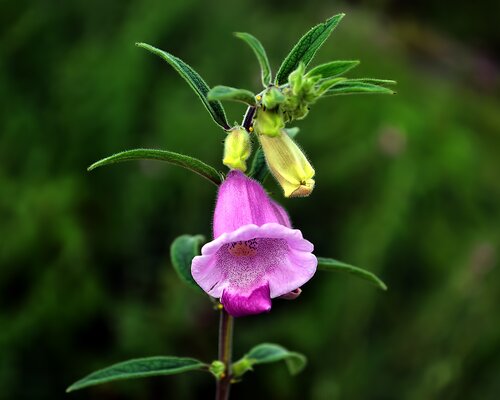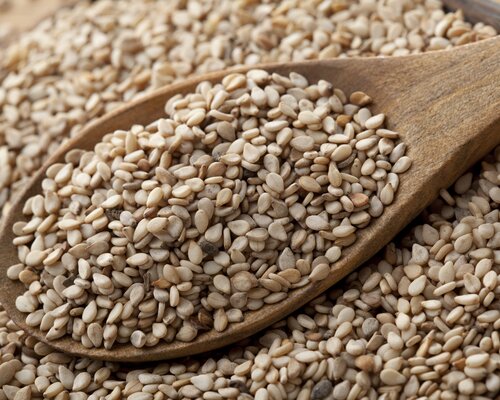Sesame
Sesamum indicum
Crop Overview
Sesame (Sesamum indicum L.) is an ancient oilseed crop believed to have originated in Africa, particularly in the region that includes modern-day Ethiopia and Sudan. It has a long history of cultivation dating back over 5,000 years. Today, sesame is widely distributed throughout Africa, Asia and the Americas, where it is cultivated for the high oil content and nutritional benefits of its seeds. Major producing countries include Sudan (4 million hectares in 2022, estimated), India (1.6 million hectares), Myanmar (1.5 million hectares) and Tanzania (0.97 million hectares). Common names include simsim in Arabic, benne in Bantu and til in Hindi.
Characteristics, Cultivation and Agricultural Practices
Sesame thrives in tropical and subtropical climates, preferring well-drained sandy or loamy soils. It is relatively drought-tolerant, requiring about 400-700 mm of rainfall for optimal growth, but does not tolerate salinity or waterlogging. The crop is resistant to several pests and diseases, including aphids, whiteflies and fungal infections like leaf spot. However, it is susceptible to diseases such as wilt and root rot, which can impact yield if not managed properly.
The global average seed yield for sesame is approximately 500 to 600 kg per hectare. However, yields can be higher, sometimes reaching up to 3.5 tonnes per hectare. Sesame is commonly grown as a monocrop as part of a crop rotation or intercropped with legumes. In northern Syria, for example, it is often planted in newly established olive groves both as a source of income and to control weeds. Traditional farming practices often involve minimal use of synthetic fertilizers and pesticides, making sesame an attractive option for sustainable agriculture.
Nutritional, Economic and Medicinal Value
Sesame seeds have the highest oil content of any of the major oil crops (up to 60%). They are also high in protein (up to 22%) and rich in vitamins, especially vitamin E, and minerals such as calcium, iron, magnesium and phosphorus, contributing to bone health and metabolic function. The seeds are also high in antioxidants, which have been linked to various health benefits, including improved heart health and reduced inflammation.
Sesame is an extremely versatile crop, being used for food, livestock feed, massage oil and cosmetics and in the production of biodiesel.
Sesame plays a crucial role in many cultures, serving as a staple ingredient in various traditional dishes, snacks and sauces, such as tahini. It is also used in making cakes and other sweets, such as the Persian halvah. The oil extracted from sesame seeds is widely used in cooking and traditional medicine, known for its high smoke point and health benefits. It is also used as a base for pharmaceutical ointments in Japan.
Cultural Importance
“Open sesame” is a magical invocation from the famous story “Ali Baba and the Forty Thieves”. In parts of Asia and Africa, sesame is often used in rituals, festivities and rites of passage. For example, in both China and Armenia, sesame seeds are believed to bring good luck and prosperity, making them a popular ingredient in celebratory foods during weddings and festivals. Sesame is used in Hindu religious rituals and is considered sacred. The crop's resilience and ability to thrive in challenging conditions further enhance its symbolic status as a sustainer of life and livelihoods.
Gender Perspectives
Women’s involvement in sesame production varies widely from country to country and is often determined by the nature of the production systems. Where the crop is grown at a small scale for subsistence, women commonly play a lead role in all aspects of the crop. However, they often face barriers such as limited access to land and other resources, training and markets. Where the crop has become more commercialized, men have tended to take over, relegating women to tasks such as weeding, harvesting, threshing and cleaning the seed.
Training in value-added processing offers opportunities to enhance women’s well-being, but may add to already high labour burdens.
Why is the Crop Underutilized?
The crop often suffers from limited market value compared with other oilseeds, such as soybeans and canola, leading to less investment in its cultivation. A major constraint to increasing sesame production is the difficulty in mechanizing harvesting due to the fragile seed head, which means that most sesame harvesting is still done manually. Other challenges include low yields, lack of improved varieties, poor pest and disease resistance, inadequate processing facilities, low consumer awareness of health benefits and vulnerability to market fluctuations.
Raising awareness about sesame's versatility and potential health benefits could stimulate demand and open new markets for farmers.
Diversity Available in Genesys
Genesys, the online platform providing information about plant genetic resources for food and agriculture conserved in genebanks worldwide, lists over 9,000 seed samples of sesame. The largest collections are held in:
- The Genetic Resources Research Institute (GeRRI) of the Kenya Agricultural and Livestock Research Organization – 1,680 samples.
- Embrapa Recursos Genéticos e Biotecnologia in Brazil – 1,520 samples.
- The N.I. Vavilov All-Russian Research Institute of Plant Industry – 1,511 samples.
- The Plant Genetic Resources Conservation Unit, Southern Regional Plant Introduction Station, University of Georgia in the USA – 1,209 samples.
Current Breeding Efforts
Organizations that have released improved sesame varieties include the Indian Council of Agricultural Research, the Ethiopian Institute of Agricultural Research, the Chinese Academy of Agricultural Sciences, the Myanmar Department of Agriculture and Bulgaria's Agricultural Academy.
Breeding efforts aim to enhance yield, suitability for mechanical harvesting, pest and disease resistance and tolerance to abiotic stresses such as drought.





